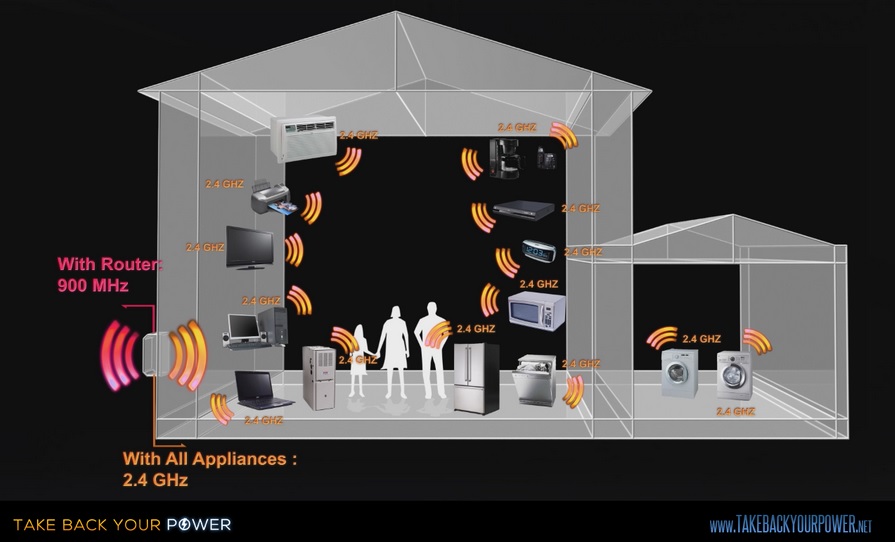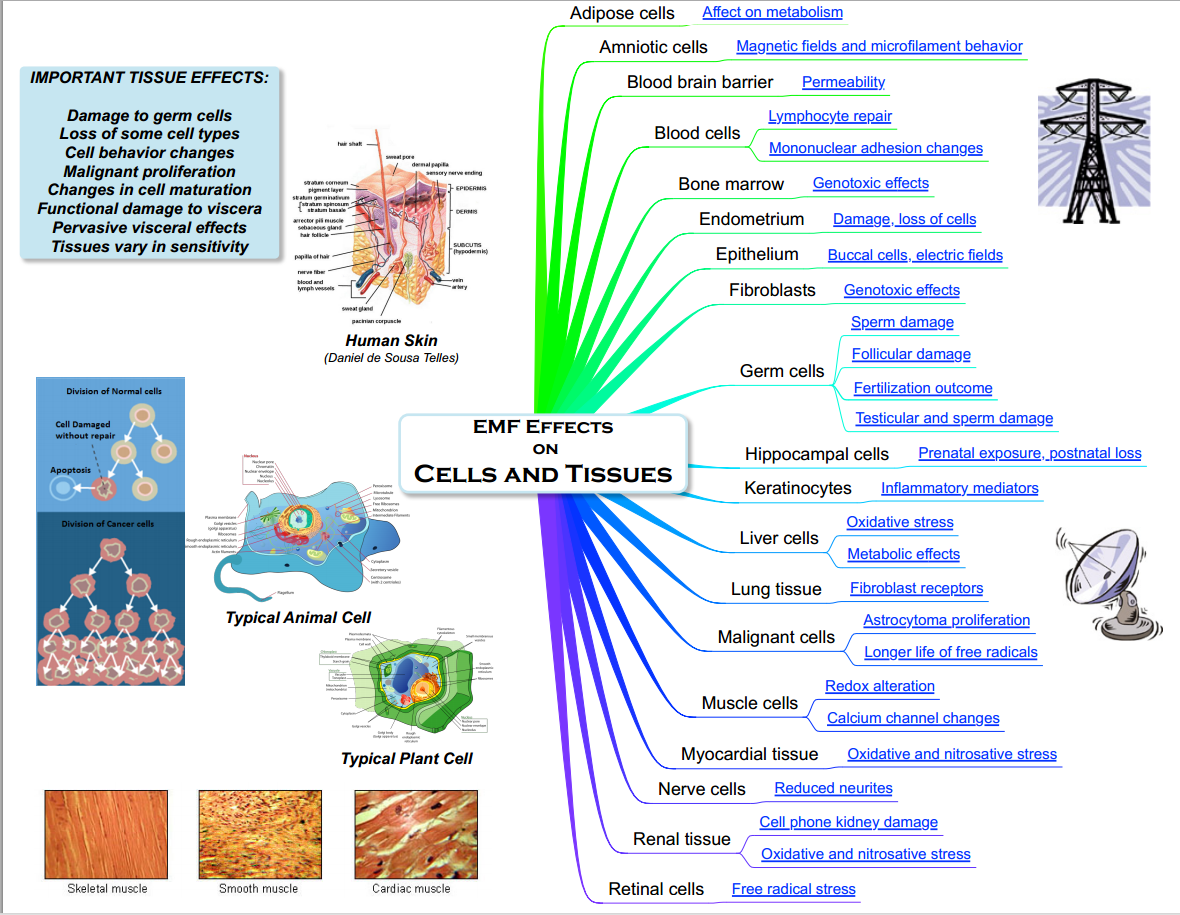Recently, I wrote about products that help protect us from harmful electromagnetic fields (EMFs) aimed towards our bodies. Certainly many of you have heard that cell phones may be harmful when placed close to your head somewhere on a passing news report or morning talk show, but the segment is so short lived that you may pay attention for a moment or two, mention it to someone later and then move on with your daily lives. Unfortunately, the naysayer technologists will go to great lengths to prove that any report saying that they’re unsafe is unfounded and not reliable.
Photo credit: www.boldognapot.hu and http://media.portland.indymedia.org/.
And so it goes. It’s not unlike the absurd arguments that cigarette smokers had in the early days when negative data came out — after all, if you were a smoker at the time, you’d likely go to great lengths to prove that the literature isn’t legit just as my prolific technology user friends are doing today. One day this will change, but it will take time just as it took time for Austrian born Dr. Ignaz Semmelweis to prove that the higher rate of death for infants and mothers in upper class hospitals in the 1840’s were related to doctors not washing their hands between autopsies and delivering babies. Dr. Semmelweis proposed something radical at the time and was ostracized by the medical community.
Despite the fact that Vienna was at the center of education and science at that time just as Silicon Valley is at the center of technology today, doctors scoffed at the idea that this idea could be the reason for higher death and disease rates just as technologist and researchers are too eager to negate reports which uncover negative findings about EMFs today. Back then, just as today, is it that egos are too strong to allow for a new truth? While we live in a “free information world,” if well respected naysayers slam the idea (a potential new truth), no one will listen to the data, despite how much of it points to potential harm to the human body.
The above graphic shows the mechanism by which EMF causes DNA damage without the heating of cells. This mechanism was found in 17 different studies and is essentially a smoking-gun that shows EMF is dangerous at levels far below government safety standards (taken from EMFAnalysis.com)
What if the best and the brightest of our time (Google, Apple, most medical doctors, etc,) are missing something huge? Our entire technological economy is based on an assumption. This assumption is that pulsed-modulated microwave radiation is completely safe and all regulations are built upon the assumption that “if it doesn’t heat you, it can’t hurt you.”
History has shown us that innovators and leaders take chances by speaking up before the rest of the world is ready to admit it, never mind absorb what it means for their lives. This is particularly hard to do if you’re going head-to-head with major industries that have poured millions of dollars into a system, which includes technology manufacturers and utility companies at a minimal. After all, who wants to go after that shooting gun?
Naysayers aside, a growing number of people are speaking up, including the former of Microsoft Canada Frank Clegg who is now committing his life to raising awareness of EMFs and unsafe technology.
If I’m not one of the people who has had to leave their home from smart meter absorption effects or am not experiencing ringing in my ears when I am in a high wifi-area, why am I going through such great lengths to write this article? Friends in my world have become sick from EMFs and there’s no doubt, I notice increased edginess, loss of concentration and tingling of hands after using my cell phone for too long, not to mention how disconnected I feel to “what’s real” when technology is at the driver’s seat. Refer to an article I wrote 5 years ago called the Year of Multiple Digital Personas, where technology was more than just an integral part of my life — it was my life.
In 2012, I wrote another piece entitled: Is Social Media Turning You Into a Low Self Esteem Anxiety-Rich Freak? At that time, I pointed to a post on How Social Media Makes Romantic Relationship Thrive that ran along side another post on Mashable entitled Social Media Fuels Low Self Esteem & Anxiety, where I discovered a study about online behavior at the time. The controversy over the impact on social issues related to technology saturation and too much time online has been discussed on and offline for years and yet, venture capitalists continue to pour money into new products, often without thinking of the social implications or the impact on our health.
The latest explosion of the Internet of Things and connected object announcements may very well have been the cherry on the cake for me. I spent the last several years playing in that world — I launched the world’s first connected fork and the first publicly announced connected electric toothbrush, believing in their vision in that the more we know about our health from the data these objects can collect can surely only make us better decision makers on how to live. I still think that this collected data (that we should own and have the right to where it ends up) is a significant shift in medicine and healthcare not to mention the fact that it gives individuals a sense of power they’ve never had before. Big data is BIG and it’s changing the world as we’ve known it. This is a positive thing, however there are products that go too far, connecting us needlessly without a goal to heal or aid us, but simply provide data for data’s sake.
Photo source: drpawluk.com.
Given that I also review products as much as I launch them, the catalyst most likely occurred after CES this past year. As I walked past booth after booth in the Digital Healthcare section of the show, I realized how many non-technology companies were getting into the game and launching pendants, watches and bracelets all connected to your smartphone via Bluetooth. These “connected products” alert you the moment you get a text message from your son, boyfriend or wife. Even Guess watches have voice commands that communicate with your smart phone and I’ve been researching sleep products that measure the depth and quality of your sleep.
Don’t get me wrong, I love the idea, but I also know that having technology in my bedroom adds to my stress and reduces the quality of sleep I get — whenever I get far away from the urban sprawl and stay in a disconnected inn surrounded by horses, nature and crackling brooks, I feel revitalized and renewed and giving my body a rest away from technology and its EMF emissions are an integral part of that.
The naysayers will surely say that my increased level of distractions and a less peaceful sleep could be a million other things, including my busy schedule, but let’s look at the data. According to an article on the International Society for Electrosmog Research (IGEF) website, 2.5 mG is the generally accepted limit of ELF magnetic field exposure and yet electrical wiring errors in your bedroom or major power lines next to our homes can create much higher fields.
That combined with the increased proliferation of smart phone installation in our homes, cell phone use (some people even have two), modems and routers in our homes, microwaves, iPads, laptops and more, why is it that we can’t acknowledge that the compound interest effect of this excessive use of technology which emits EMFs regardless of their levels, won’t have a profound negative impact on our bodies and society as a whole?
Photo source from the film Take Back Your Power: http://takebackyourpower.net/
“Cell towers should not be within a mile and a half of humans, yet they’re deliberately placed on medical buildings within densely populated housing areas and on schools and recreation areas. It’s a living tragedy in slow motion.”!
~ Barry Trower, Physicist & Former Military Expert on Microwave Radiation
Is the hard resistance because people are so addicted to devices that give them the brightest best eye candy they’ve ever seen, that they can’t give up the “crack effect” of checking a text message every few minutes regardless of what else they’re doing, like having a conversation with someone at dinner? Is it perhaps that it fulfills some inherent need they aren’t getting elsewhere in their life? Why people need to immediately check an alert that tells them someone just commented on a Facebook post at midnight is beyond me, but it I see it happen around me all the time.
This is a social effect that is proliferating our society, destroying the quality of real-time human interaction as we have always known it and this is running alongside the physical health impact. As more and more scientific reports come out and an increasingly number of people in and outside my circles are experiencing issues related to the increased levels of EMFs, it’s time we brought this conversation to a more serious level, just as people like Jeromy Johnson and Frank Clegg are doing in public and private forums around the world.
It’s clear that some people are more sensitive to electromagnetic fields than others. Even if you haven’t experienced an “issue,” don’t discount that other’s symptoms are real and don’t discount that the number of issues being reported are going up every day.
Photo source: emfnews.com.
Being smart about your health means knowing all the facts and it’s hard to ignore the alarming number of reports that suggest “caution and more investigation needed,” yet no grave alarm bells are going off….yet. Just as cigarette manufacturers poo-pooed the ill-effect of tobacco for years as did cigarette smokers, the strain from being saturated in technology waves will have its ill hey-day and likely sooner than you think.
In March, we finally saw a crack in the naysayer’s iron wall of resistance when respected New York Times reporter Nick Bolton wrote an article on the health concerns in wearable tech. It’s interesting but not surprising that an Editor’s Note was added shortly thereafter that included the following sentence: “Neither epidemiological nor laboratory studies have found reliable evidence of such risks, and there is no widely accepted theory as to how they might arise.” I perceived this as a “on second thought, don’t worry about this, false alarm”. Here’s Jeromy Johnson’s response to the article on EMF Analysis.com.
Geeks and non-believers may very well ask for proof that someone’s brain tumor is directly connected to cell phone overuse or that a report can somehow lay claim over a death. The urgent issue on the table RIGHT NOW however is a need for increased awareness, not just for those who proactively spend hours on Google getting the under-discussed facts. We shouldn’t expect that everyone will go under the hood to do the in-depth research necessary to be safe just as we shouldn’t expect people to know that potentially deadly chemicals are in the water they drink or the soil where their vegetables grow.
Information on how to protect ourselves and reduce these fields, keeping them as far away from our heads, hearts, breasts and other vital organs as possible, should be discussed more openly, including on broadcast news on a regular basis, not as a way to alarm the public at large, but as a way for all of us as a society to take the protective measures to keep us safe, especially our children. Let’s remember that there is a whole new generation who are getting exposed to an all-technology world as early as they leave their mother’s womb. Seeing a baby’s photo with a wifi-happy iPad lying on their stomach as they push buttons makes me shudder.
Photo credit from DDees.com.
As soon as I bring up the issue of EMF issues for cell phones in my Silicon Valley circles, the conversation always gets a little weird…..people suddenly start fidgeting and looking for any excuse at all to change the subject, as if I’m the party pooper aka the big elephant in the room they want to silence. After all, who wants to talk about the negative effect of cell phones when you know yourself that you just spent the last 5, 10, 15, 20, maybe 25 years using one, all without protective measures? Let’s face it — “it’s not a fun conversation.”
Photo source: consciousnourishment.org.
So, what do we actually know about EMFs and why should you really care? First, the safety guidelines meant to protect us are outdated, based on an idea from the 1950’s that as long as EMFs don’t heat you, they can’t possibly hurt you. FCC safety guidelines haven’t been updated in almost 20 years and rely upon this myth, however, much of the recent independent science shows this notion to be obsolete. Serious biological effects (things like DNA damage and infertility) are being found at levels far below the energy required to heat tissue. Listen to Frank Clegg in this video pointing out that the safety guidelines “are not even in the 21st century.”
The second reason to be concerned about pulsed digital microwave radiation is that our exposure has grown exponentially over the past ten years. Think about it: we have went from 2G to 3G to 4G, each with greater frequency modulation, which is a primary cause for biological effects. The ubiquity of smart phones the past seven years has also caused a massive increase in the number of cell towers in our neighborhoods. WiFi is now everywhere (including schools) and has become much more powerful. Some of the latest routers now have two powerful antennas – one for your home and one for the public. Yes, your home is now a public hotspot – essentially acting as a cell tower in your living room. Add in wireless baby monitors, cordless phones, smart meters, driver-less cars, and we are creating a man-made electromagnetic soup that humanity has never experienced.
Any one of these technologies by itself with limited access may be safe. However, when combined with all the other frequencies, it’s no wonder that a growing number of people are experiencing health effects and international bodies of scientists are sounding the alarm.
“Electromagnetic pollution (EMF) may be the most significant form of
pollution human activity has produced in this century!”
~ Dr. Andrew Weil, Health Expert
Get informed, do some digging, don’t be afraid to ask hard questions and read between the lines….you know, the small print in the brochures that come with your cell phones. Be sure to read my Cruz case review and my write-up on a host of products which can help keep you safer.
Useful Resources:
- Film entitled: “Resonance – Beings of Frequency”
- Film entitled: “Take Back Your Power.”
- EMF Analysis: www.emfanalysis.com, which also provides practical solutions that we all can utilize.
- Less EMF: www.lessemf.com, a site that has a host of products you can buy to help shield you from the harmful effects.
- My Product Write-up on products which are designed to offset some of the EMF emissions.
- Diagnose-Funk out of Germany at www.diagnose-funk.org/.
- International Society for Electrosmog Research: http://www.elektrosmog.com.
Note: I am not a doctor, scientist, researcher or developer, so understand that this post is merely a raise for concern, a plea to a stronger and louder discussion about keeping technology safe. I am not making claims, not am I placing blame — I am simply writing about my experience and expressing my opinion based on what I’m seeing, reading and feeling.

Renee Blodgett is the founder of We Blog the World. The site combines the magic of an online culture and travel magazine with a global blog network and has contributors from every continent in the world. Having lived in 10 countries and explored nearly 80, she is an avid traveler, and a lover, observer and participant in cultural diversity.
She is also the CEO and founder of Magic Sauce Media, a new media services consultancy focused on viral marketing, social media, branding, events and PR. For over 20 years, she has helped companies from 12 countries get traction in the market. Known for her global and organic approach to product and corporate launches, Renee practices what she pitches and as an active user of social media, she helps clients navigate digital waters from around the world. Renee has been blogging for over 16 years and regularly writes on her personal blog Down the Avenue, Huffington Post, BlogHer, We Blog the World and other sites. She was ranked #12 Social Media Influencer by Forbes Magazine and is listed as a new media influencer and game changer on various sites and books on the new media revolution. In 2013, she was listed as the 6th most influential woman in social media by Forbes Magazine on a Top 20 List.
Her passion for art, storytelling and photography led to the launch of Magic Sauce Photography, which is a visual extension of her writing, the result of which has led to producing six photo books: Galapagos Islands, London, South Africa, Rome, Urbanization and Ecuador.
Renee is also the co-founder of Traveling Geeks, an initiative that brings entrepreneurs, thought leaders, bloggers, creators, curators and influencers to other countries to share and learn from peers, governments, corporations, and the general public in order to educate, share, evaluate, and promote innovative technologies.















